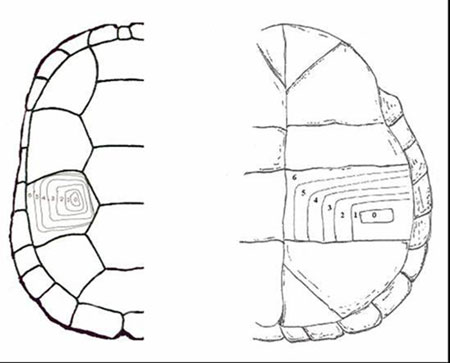To determine the age of a box turtle, count the growth rings on its scutes. These rings indicate age.
Box turtles can live up to 100 years, with accurate age determination crucial for conservation efforts. Understanding the age of a box turtle can help researchers track population trends, monitor conservation efforts, and ensure the longevity of these fascinating creatures.
By accurately determining the age of box turtles, scientists can implement targeted conservation strategies to protect these species for future generations. Let’s delve deeper into the methods and importance of age determination in box turtles.
Physical Characteristics
When determining the age of a box turtle, examining its physical characteristics can provide valuable insights. By observing specific features, such as shell growth rings, size, and weight, one can estimate the turtle’s age with reasonable accuracy.
Shell Growth Rings
Box turtles, like many other turtle species, develop growth rings on their shells over the years. These rings are similar to the growth rings found in trees and can be used to estimate the turtle’s age. Each year, a new growth ring forms on the turtle’s scutes, providing a visual indicator of its age.
Size And Weight Comparison
Comparing the size and weight of a box turtle to the average measurements for its species can also offer clues about its age. Younger turtles are typically smaller and lighter, while older individuals tend to be larger and heavier. By assessing these physical attributes, one can make an educated guess about the turtle’s age.
Behavioral Observations
Behavioral observations are an important aspect of determining the age of a box turtle. By closely monitoring their activities and reproductive behavior, you can gain valuable insights into their age and overall health.
Activity Levels
One way to determine the age of a box turtle is by observing its activity levels. Younger turtles tend to be more active, constantly exploring their environment and displaying high energy levels. As they age, their activity levels may decrease, and they may become more sedentary.
Reproductive Behavior
Another indicator of a box turtle’s age is its reproductive behavior. Mature turtles exhibit specific mating behaviors and may lay eggs. By monitoring their reproductive activities, such as courtship rituals and nesting behaviors, you can make an educated guess about their age.
Habitat And Environment
Location And Habitat Type
Box turtles are found in a variety of habitats ranging from forests to grasslands.
Environmental Factors
Temperature and humidity play crucial roles in a box turtle’s age determination.

Credit: boxturtle.uncg.edu
Scientific Methods
When it comes to determining the age of a box turtle, scientific methods play a crucial role in providing accurate and reliable results. By utilizing advanced techniques such as radiography and DNA analysis, researchers can gain valuable insights into the age and life history of these fascinating creatures.
Radiography
Radiography is a non-invasive method used to determine the age of box turtles by examining their internal skeletal structure. Through the use of X-rays, scientists can assess the growth rings present in the turtle’s bones, providing valuable information about its age and growth patterns.
Dna Analysis
DNA analysis offers a highly precise method for determining the age of box turtles. By analyzing the genetic material extracted from a turtle’s tissue samples, researchers can gain insights into its age, genetic lineage, and potential lifespan. This advanced technique has revolutionized the study of box turtle populations and has provided valuable data for conservation efforts.
Conservation Implications
Impact Of Age Determination On Conservation Efforts
Accurately determining the age of box turtles is crucial for effective conservation efforts. Understanding the age distribution within a population helps conservationists assess the overall health and viability of the species.
By knowing the age structure, conservationists can identify potential threats to specific age groups, such as the impact of habitat destruction on younger turtles, or the vulnerability of older turtles to certain environmental stressors. This information guides targeted conservation strategies to address the specific needs of different age groups within the population.
Protection Of Older Turtles
Age determination also plays a vital role in protecting older turtles. Older turtles are often key contributors to the population as they have survived various environmental challenges and have valuable genetic diversity. Ensuring the survival and reproductive success of older turtles is essential for maintaining the resilience and adaptability of the population.
Conservation efforts can be tailored to focus on preserving the habitats and resources that older turtles rely on, as well as implementing measures to reduce threats that specifically impact this age group.

Credit: m.youtube.com
Ethical Considerations
To determine the age of a box turtle, ethical considerations are crucial. By analyzing the turtle’s growth rings in its scutes and examining its size and maturity, experts can estimate its age. This process helps ensure the well-being and conservation of these fascinating creatures.
Handling Guidelines
When handling box turtles, ensure gentle, respectful care to avoid stress.
Handle them with clean hands to prevent the transfer of harmful bacteria.
Respecting The Natural Habitat
Avoid removing box turtles from their natural habitat for observation.
Respect their environment to maintain their well-being and ecosystem balance.

Credit: www.wikihow.com
Conclusion
Box turtles are fascinating creatures, and their age is a crucial factor in understanding their behavior and habitat preferences. By observing the shell, analyzing growth patterns, and examining the physical characteristics, you can easily determine the age of a box turtle.
Understanding their age can also help in their conservation and management. With these simple techniques, you can accurately determine the age of a box turtle and gain a better understanding of their ecology. So, next time you spot a box turtle, take a closer look and try to determine its age!






Leave a Reply